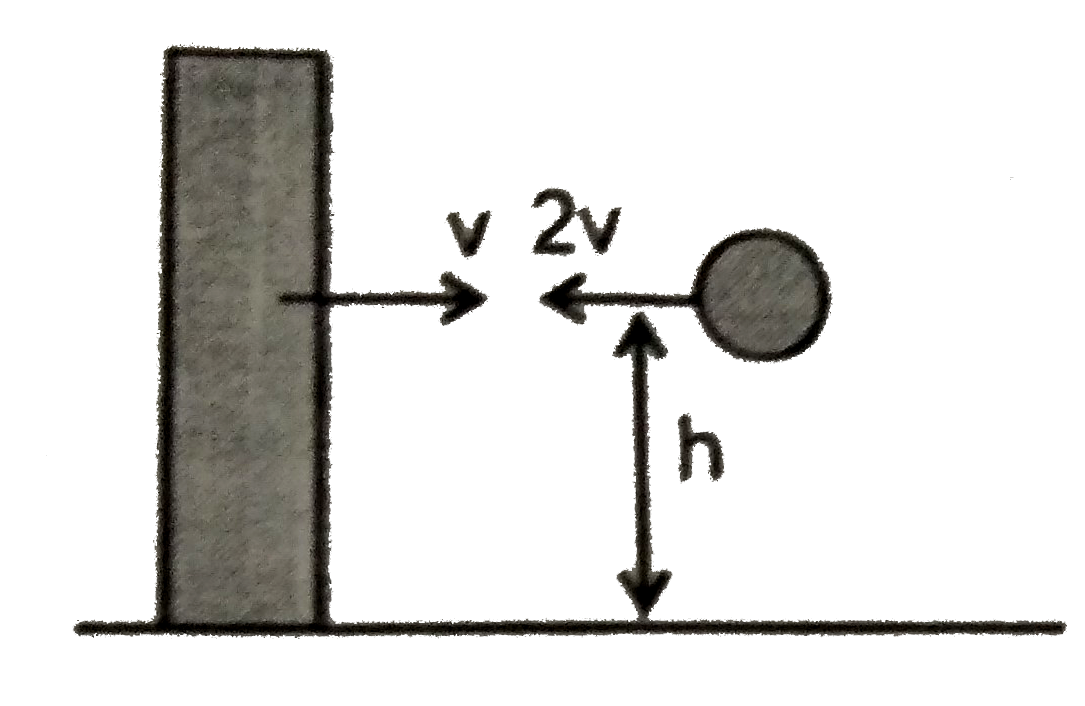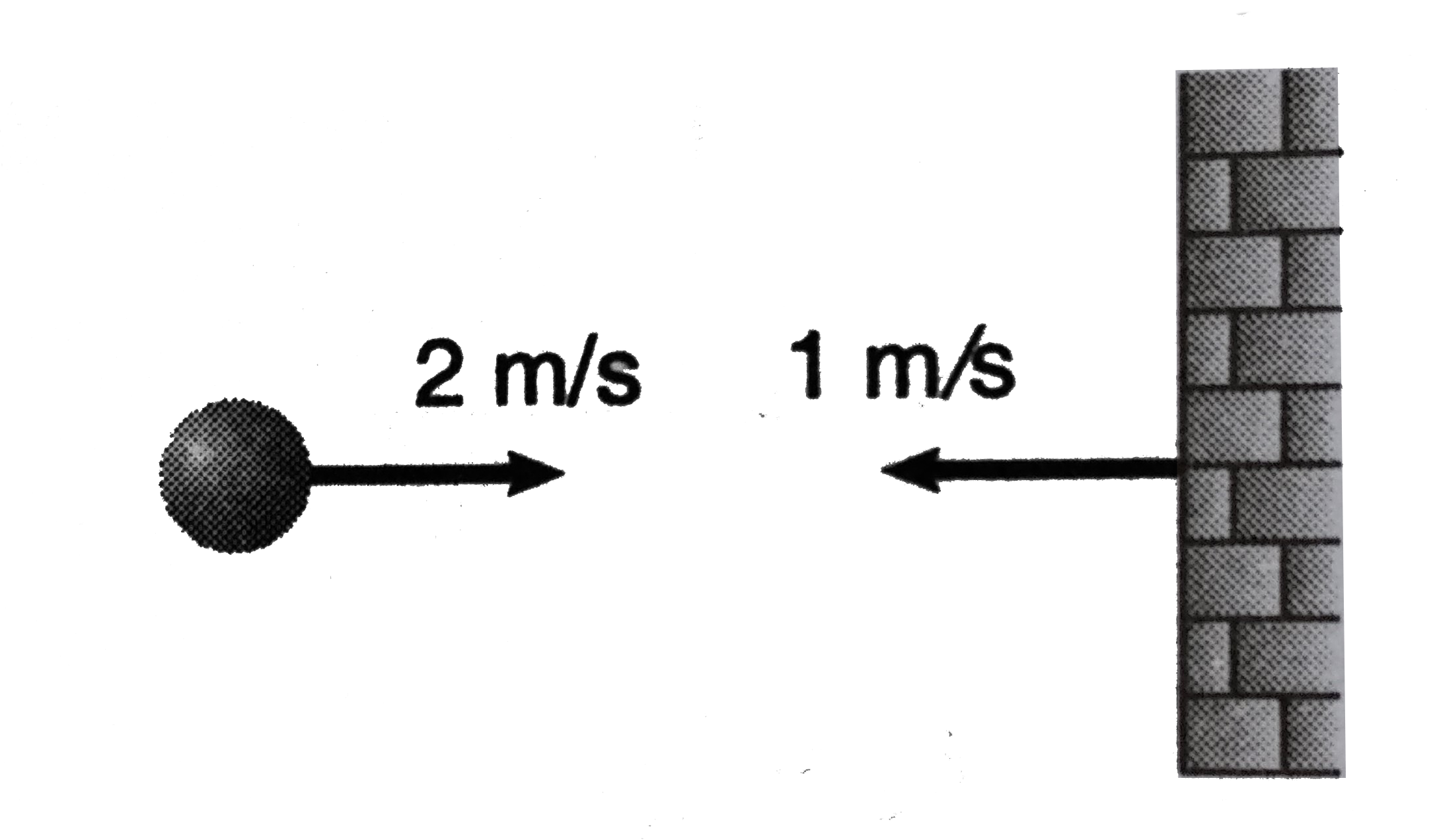A ball collides elastically with a massive wall moving towards it with a velocity of v as shown. The collision occurs at a height of h above ground level and the velocity of the ball just before collision is 2v in horizontal direction. The distance between the foot of the wall and the point on the ground where the ball lands, at the instant the ball lands, will be :

v√2hg
2v√2hg
3v√2hg
4v√2hg
The correct Answer is:C
Solve in the reference frame fixed to the wall.
Before collision, velocity of ball =3v towards it .
∴ After elastic collision of ball=3v away from it
Time of flight =√2hg
∴ distance between wall and ball
=3v.√2hg.
( Here no pseudo force is applied since the wall keeps on moving with constant velocity w.r.t. ground, it being very heavy ).
Topper's Solved these Questions
- DAILY PRACTICE PROBLEMSBook:RESONANCEChapter:DAILY PRACTICE PROBLEMSExercise:DPP 62
Explore 4 Videos
- DAILY PRACTICE PROBLEMSBook:RESONANCEChapter:DAILY PRACTICE PROBLEMSExercise:dpp 63
Explore 5 Videos
- DAILY PRACTICE PROBLEMSBook:RESONANCEChapter:DAILY PRACTICE PROBLEMSExercise:dpp 60
Explore 5 Videos
- CURRENT ELECTRICITYBook:RESONANCEChapter:CURRENT ELECTRICITYExercise:Exercise
Explore 54 Videos
- ELASTICITY AND VISCOCITYBook:RESONANCEChapter:ELASTICITY AND VISCOCITYExercise:Advanced Level Problems
Explore 9 Videos
Similar Questions
A ball is falling a height of 50 m . It strikes the ground and rebounds to a height of 10 m . Calculate the velocity of the ball just before and after the collision . Also find the loss of kinectic energy of the ball during its collisio with ground .
View SolutionIf a ball strikes with a velocity u1 at the wall which itself is approaching it with a velocity u2 then find the velocity of the ball after collision with the wall.
View Solution
Knowledge Check
A ball moving with a velocity v hits a massive wall moving towards the ball with a velocity a. An elastic impact lasts for time △t
AThe average elastic force acting on the ball is [m(u+v)]/△tBThe average elastic force acting on the ball is [2m(u+v)]/△tCThe kinetic energy of the ball increases by 2mu(u+v).DThe kinetic energy of the ball remains the same after the collision.A ball moving with a velocity v hits a massive wall moving towards the ball with a velocity a. An elastic impact lasts for time △t
AThe average elastic force acting on the ball is m(u+v)ΔtBThe average elastic force acting on the ball is 2m(u+v)ΔtCthe kinetic energy of the ball increases by 2mu (u + v)Dthe kinetic energy of the ball does not changeA glass ball collides with a smooth horizontal surface (xz plane) with a velocity V=ai−bj. If the coefficient of restitution of collision be e, the velocity of the ball just after the collision will be
A√e2a2+b2 at angle tan−1(aeb) to the verticalB√a2+e2b2 at angle tan−1(aeb) to the verticalC√a2+b2e2 at angle tan−1(eab) to the verticalD√a2e2+b2 at angle tan−1(aeb) to the vertical
A ball of mass m moving with velocity v collides head on elastically with another identical ball moving with velocity - V. After collision
View SolutionA ball is moving with velocity 2m/s towards a heavy wall moving towards the ball with speed 1m/s as shown in figure. Assuming collision to be elastic, find the velocity of ball immediately after the collision.

View SolutionA ball A of mass M collides elastically with a similar ball B at rest as shown in figure. Initially velocity of ball A is u m/s. After collision,

View SolutionA highly elastic ball moving at a speed of 3m/s approaches a wall moving towards it with a speed of 3m/s. After the collision. the speed of the ball will be

View SolutionA truck moving on horizontal road towards east with velocity 20ms1 collides elastically with a light ball moving with velocity 25ms−1 along west. The velocity of the ball just after collision
View Solution

